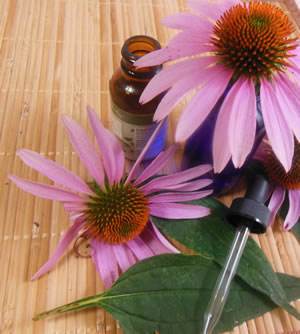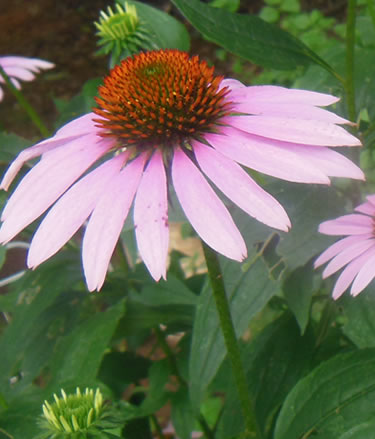Echinacea Echinacea angustifolia

Echinacea purpurea
- Common Names
- Echinacea , Purple coneflower
- Botanical Name
- Echinacea angustifolia
- Family
- ASTERACEAE
Medicinal Uses & Benefits of Echinacea
![]() How to Use|
Side Effects |
Plant & Garden|
How to Use|
Side Effects |
Plant & Garden|
- Medicinal Uses: * Candida/yeast
* Colds
* Ear
* Immune
* Insect/flea Bites
* Sinus
* Sore Throat
- Properties: * Anti-inflammatory * Antibacterial * AntiViral * Depurative * emetic * Immunostimulant
- Parts Used: Most often roots, stems and flowers are also used but are weaker
- Constituents: essential oil (including humulene and caryophylene), glycoside, polysaccharide, polyacetylenes, isobutylalklamines, resin, betaine, inulin, sesquiterpene.
How to Use: Echinacea
Herbalists do not agree on which species is best, E.purpurea,, E. pallida, or E.angustifolia, but all variants have phytochemicals that improve the immune system. There are dozens of dozens of biochemical compounds that act in therapeutic synergy in this complex plant that support disease resistance in several ways. However, taking echinacea when a cold or infection has already become serious may be fighting a losing battle. Echinacea is most effect when taken at the first onset of cold, sinus, gum inflammation or other infection symptoms. 92 110
Echinacea has a numbing sensation that relieves the pain of cold sores, and also offers some protection against herpes simplex viruses. 92 Echinacea acts against Candida albicans, the microorganism that causes most yeast infection. Echinacea is a mild antiseptic on its own, but when fighting an established virus, combining echinacea with antiseptic herbs such as goldenseal or Oregon grape enhances the effectiveness of the treatment. 102
A few drops of echinacea tincture or a skin wash made from fresh flowers in a quick and effective way to reduce itching and take the sting out of insect bites and hives. 59
Preparation Methods & Dosage :Dosage is key. You need to take enough echinacea, and take it frequently enough, to do any good. Capsules are convenient, but not as efficient, and quite often not as potent as tinctures. Echinacea is by no means a good tasting herb for tea, but echinacea tea can be used in compresses and poultices for external applications.
Echinacea Remedies
Echinacea Side Effects: Use with caution if you are allergic to ragweed. If you have an autoimmune disease such as rheumatoid arthritis or lupus, or a chronic infection such as HIV/AIDS or tuberculosis, you should not use echinacea.
Plant Description

Echinacea - purple coneflower
Nine species of Echinacea grow perennially throughout Midwestern North America from Saskatchewan to as far south as Texas. The three species most used and studied are E.purpurea, E. pallida, and E.angustifolia. They are hard to tell apart, all have pretty purple flowers except for E. paradoxa, whose flowers are yellow.
Regional Traditions :North America *
How to Grow Echinacea
Purple Coneflowers - - Echinacea spp is on the United Plant Savers "At Risk" list. Wildcraft this plant responsibly and consider growing it if you have suitable garden space. Echinacea is a such a pretty plant, and so easy to grow it earns a valued place in the herb garden even if you don't wish to harvest the medicinal roots. There are many new and fancy cultivars with multicolored flowers, but stick with the old standards if you want to grow the plant for medicine as well as for its beauty. Drought resistant perennial. Grows best in full sun, but can tolerate some shade.
History and Traditions & Folklore
North American Indians passed the knowledge of the purple coneflower on to the colonists and settlers of North America. Echinacea became a famed remedy for snake bite and for cleansing and healing suppurating wounds.- 102. Duke,James, Ph.D. "The Green Pharmacy Herbal Handbook"
- 92. White Linda B., M.D. "The Herbal Drugstore" (2003)
- 93. Mabey, Richard." New Age Herbalist", The (1988)











